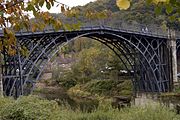Iron Foundries
I worked the best part of my life for a company (Foseco in Nechells) selling consumables to the foundry trade.
Very quickly, iron foundries were at the top end of the foundry trade in terms of size, as the equipment required for melting iron was large and required a good deal of space. A typical iron casting is a car-engine cylinder block or cylinder head. Made in a sand-mould comprising special sand bonded with clay or chemicals. There were relatively few iron-foundries in and around Birmingham, and the ones that did exist largely supplied the shipping and, later, the car industry. My g-g-g-grandfather was a Mr Kesterton of Aston who was described as an 'iron-master', and he ran a foundry that in the mid-19th century produced parts for things like stoves, gratings, drains, window-frames, and so forth. Iron was melted in a device known as a cupola, the operation of which could be seen from miles away in the shape of flames and clouds of acrid smoke. The large iron foundries were located mostly in the Black Country, as this area was close to the coal-fields, as it was coal and coke that was used to fuel the cupolas (and later the blast-furnaces for steel-casting - a very different technique and one which eventually became dependent upon electricity).
In Birmingham, the majority of foundries were engaged in the casting of non-ferrous metals, mostly brass and gun-metal, and latterly aluminium. These metals required far less in the way of energy to melt, and were also used to produce, in the main, smaller castings such as gas-fittings, pots and pans, gun parts, etc. These days, there are still firms which produce small non-ferrous castings for precision-instruments, cars and aircraft parts, jewellery, etc. But the techniques they use are very far removed from the old days.
I have a photo of yours truly standing in one of the bores of a marine-engine block casting made at GEC Rugby in the 1980's. Such castings these days come mostly from Eastern Europe or India.
I can tell you that molten metal exerts a certain fascination....
Big Gee











